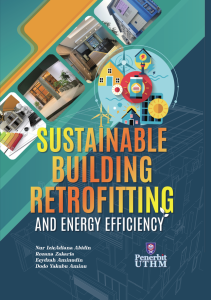Sustainable Building Retrofitting and Energy Efficiency
Synopsis
This book introduces various topics related to energy efficiency abd sustainable retrofitting. The topics cover researches and studies on the initiatives, strategies, reduction and improvements, application, effect and approach.Chapter 1 discussed the steps of retrofitting initiatives that can be implement to achieve building energy reduction. Retrofitting initiatives consists of three steps which are lean energy, green technology and clean energy. Chapter 2 focuses on giving an overview of green building assessment tools, the concept of retrofitting and retrofitting technologies. Chapter 3 discussed the building lighting energy simulation for retrofitting the Rest and Service Area (RSA) at Ayer Keroh Malaysia, which conducted using the Revit BIM model. Chapter 4 presents the prototyping of retrofitting strategies in the educational building to reuse a building type or building design. Chapter 5 reveals the strategies for mitigating the influence for modernism towards sustainable retrofitting of Hausa traditional palaces. Chapter 6 presenting the attitude towards energy consumption and strategies to encourage energy efficiency in a building. The energy consumption and occupant's well-being besed on the retrofitting implemented in the office building at National Primary Health Care Development Agency Abuja were highlighted in Chapter 7. Chapter 8 reveals cool paint application to the indoor temperature conducted at the student hostel room in UTM presidential college. Lastly, Chapter 9 highlighted the passive design approach of building envelope for individual residents in achieving energyefficient building.
Downloads
References
Abdullah Saleh, A. A., Mohammed, A. H., and Abdullah, M. N. (2015). Critical Success Factors for Successful
Energy Management Implementation towards Sustainability in Malaysian Universities. International Journal of Social, Behavioral, Educational, Economic and Management Engineering, 9(3), 734–742.
Abdelazim, A. I., Ibrahim, A. M., and Aboul-Zahab, E. M. (2016). Development of An Energy Efficiency
Rating System for Existing Buildings Using Analytic Hierarchy Process – The Case of Egypt. Renewable and Sustainable Energy Reviews,71, 414-425.
Ascione, F., Masi, R.F.D., Rossi, F. De, Ruggiero,S., and Vanoli,G.P. (2016). Optimization of Building Envelope Design for nZEBs in Mediterranean Climate: Performance Analysis of Residential Case Study. Applied Energy, 183, 938–957.
Baker, J., Brandenburg, M., and Herbst, R. (2012). United States Building Energy Efficiency Retrofits. (1st ed). United States: Rockefeller Foundation.
Chee Yu, J.L. (2014). OTTV Calculation and Energy Simulation Technique for GreenRE Rating System. Integrated Environmental Solutions.
Chung, M. H., and Rhee, E. K. (2014). Potential Opportunities for Energy Conservation in Existing Buildings on University Campus: A field survey in Korea. Energy and Buildings, 78, 176–182.
Chwieduk, D. A. (2017). Towards Modern Options of Energy Conservation in Buildings. Renewable Energy,
, 1194–1202.
Danby, D., Menter, A., and Faludi, J. (2011). Passive Design Strategies. Retrieved From: http:// sustainabilityworkshop.autodesk.com/buildings/passive-design- strategies
Di Stefano, J. (2000). Energy Efficiency and The Environment: The Potential for Energy Efficient Lighting to Save Energy and Reduce Carbon Dioxide Emissions at Melbourne University, Australia. Energy, 25(9), 823–839.
Eriksson, R., Nenonen, S., Junghans, A., Nielsen, S.B., Lindahl,G. (2015). Nordic Campus Retrofitting
Concepts – Scalable Practices. Procedia Economics and Finance. 349-336.
Hassan, F. (2014). Application of Green Technology in Malaysia Construction: Have We Got It Right? International Construction Week & Ecobuild SEA 2014. Kuala Lumpur.
Li, D. H. W., Yang, L., and Lam, J. C. (2013). Zero Energy Buildings and Sustainable Development Implications -A Review. Energy, 54, 1–10.
Lu, Y., Wang, S., Yan, C., and Huang, Z. (2017). Robust Optimal Design of Renewable Energy System in
Nearly/Net Zero Energy Buildings Under Uncertainties. Applied Energy, 187, 62–71.




